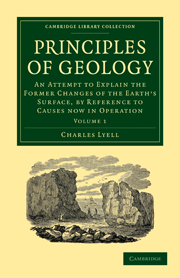 Principles of Geology
Principles of Geology Book contents
- Frontmatter
- Contents
- LIST OF PLATES AND WOOD-CUTS IN THE FIRST VOLUME
- CHAPTER I
- CHAPTER II
- CHAPTER III
- CHAPTER IV
- CHAPTER V
- CHAPTER VI
- CHAPTER VII
- CHAPTER VIII
- CHAPTER IX
- CHAPTER X
- CHAPTER XI
- CHAPTER XII
- CHAPTER XIII
- CHAPTER XIV
- CHAPTER XV
- CHAPTER XVI
- CHAPTER XVII
- CHAPTER XVIII
- CHAPTER XIX
- CHAPTER XX
- CHAPTER XXI
- CHAPTER XXII
- CHAPTER XXIII
- CHAPTER XXIV
- CHAPTER XXV
- CHAPTER XXVI
- INDEX
- Frontmatter
- Contents
- LIST OF PLATES AND WOOD-CUTS IN THE FIRST VOLUME
- CHAPTER I
- CHAPTER II
- CHAPTER III
- CHAPTER IV
- CHAPTER V
- CHAPTER VI
- CHAPTER VII
- CHAPTER VIII
- CHAPTER IX
- CHAPTER X
- CHAPTER XI
- CHAPTER XII
- CHAPTER XIII
- CHAPTER XIV
- CHAPTER XV
- CHAPTER XVI
- CHAPTER XVII
- CHAPTER XVIII
- CHAPTER XIX
- CHAPTER XX
- CHAPTER XXI
- CHAPTER XXII
- CHAPTER XXIII
- CHAPTER XXIV
- CHAPTER XXV
- CHAPTER XXVI
- INDEX
Summary
As the proofs enumerated in the last chapter indicate that the earth's surface has experienced great changes of climate since the deposition of the older sedimentary strata, we have next to inquire, how such vicissitudes can be reconciled with the existing order of nature. The cosmogonist has availed himself of this, as of every obscure problem in geology, to confirm his views concerning a period when the laws of the animate and inanimate world were wholly distinct from those now established; and he has in this, as in all other cases, succeeded so far, as to divert attention from that class of facts, which, if fully understood, might probably lead to an explanation of the phenomenon. At first, it was imagined that the earth's axis had been for ages perpendicular to the plane of the ecliptic, so that there was a perpetual equinox, and unity of seasons throughout the year:—that the planet enjoyed this ‘paradisiacal’ state until the era of the great flood; but in that catastrophe, whether by the shock of a comet, or some other convulsion, it lost its equal poize, and hence the obliquity of its axis, and with that the varied seasons of the temperate zone, and the long nights and days of the polar circles. When the advancement of astronomical science had exploded this theory, it was assumed, that the earth at its creation was in a state of fluidity, and red hot, and that ever since that era it had been cooling down, contracting its dimensions, and acquiring a solid crust, an hypothesis equally arbitrary, but more calculated for listing popularity, because, by referring the mind directly to the beginning of things, it requires no support from observations, nor from any ulterior hypothesis.
- Type
- Chapter
- Information
- Principles of GeologyAn Attempt to Explain the Former Changes of the Earth's Surface, by Reference to Causes now in Operation, pp. 104 - 124Publisher: Cambridge University PressPrint publication year: 2009First published in: 1830
